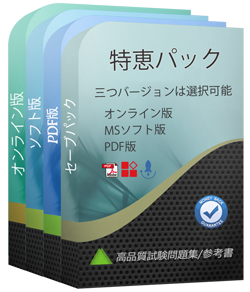割引はありますか?
我々社は顧客にいくつかの割引を提供します。 特恵には制限はありません。 弊社のサイトで定期的にチェックしてクーポンを入手することができます。
更新されたDatabricks-Certified-Data-Engineer-Professional試験参考書を得ることができ、取得方法?
はい、購入後に1年間の無料アップデートを享受できます。更新があれば、私たちのシステムは更新されたDatabricks-Certified-Data-Engineer-Professional試験参考書をあなたのメールボックスに自動的に送ります。
あなたはDatabricks-Certified-Data-Engineer-Professional試験参考書の更新をどのぐらいでリリースしていますか?
すべての試験参考書は常に更新されますが、固定日付には更新されません。弊社の専門チームは、試験のアップデートに十分の注意を払い、彼らは常にそれに応じてDatabricks-Certified-Data-Engineer-Professional試験内容をアップグレードします。
Tech4Examはどんな試験参考書を提供していますか?
テストエンジン:Databricks-Certified-Data-Engineer-Professional試験試験エンジンは、あなた自身のデバイスにダウンロードして運行できます。インタラクティブでシミュレートされた環境でテストを行います。
PDF(テストエンジンのコピー):内容はテストエンジンと同じで、印刷をサポートしています。
あなたのテストエンジンはどのように実行しますか?
あなたのPCにダウンロードしてインストールすると、Databricks Databricks-Certified-Data-Engineer-Professionalテスト問題を練習し、'練習試験'と '仮想試験'2つの異なるオプションを使用してあなたの質問と回答を確認することができます。
仮想試験 - 時間制限付きに試験問題で自分自身をテストします。
練習試験 - 試験問題を1つ1つレビューし、正解をビューします。
Databricks-Certified-Data-Engineer-Professionalテストエンジンはどのシステムに適用しますか?
オンラインテストエンジンは、WEBブラウザをベースとしたソフトウェアなので、Windows / Mac / Android / iOSなどをサポートできます。どんな電設備でも使用でき、自己ペースで練習できます。オンラインテストエンジンはオフラインの練習をサポートしていますが、前提条件は初めてインターネットで実行することです。
ソフトテストエンジンは、Java環境で運行するWindowsシステムに適用して、複数のコンピュータにインストールすることができます。
PDF版は、Adobe ReaderやFoxit Reader、Google Docsなどの読書ツールに読むことができます。
購入後、どれくらいDatabricks-Certified-Data-Engineer-Professional試験参考書を入手できますか?
あなたは5-10分以内にDatabricks Databricks-Certified-Data-Engineer-Professional試験参考書を付くメールを受信します。そして即時ダウンロードして勉強します。購入後にDatabricks-Certified-Data-Engineer-Professional試験参考書を入手しないなら、すぐにメールでお問い合わせください。
返金するポリシーはありますか? 失敗した場合、どうすれば返金できますか?
はい。弊社はあなたが我々の練習問題を使用して試験に合格しないと全額返金を保証します。返金プロセスは非常に簡単です:購入日から60日以内に不合格成績書を弊社に送っていいです。弊社は成績書を確認した後で、返金を行います。お金は7日以内に支払い口座に戻ります。
Databricks Certified Data Engineer Professional 認定 Databricks-Certified-Data-Engineer-Professional 試験問題:
1. A user new to Databricks is trying to troubleshoot long execution times for some pipeline logic they are working on. Presently, the user is executing code cell-by-cell, using display() calls to confirm code is producing the logically correct results as new transformations are added to an operation. To get a measure of average time to execute, the user is running each cell multiple times interactively.
Which of the following adjustments will get a more accurate measure of how code is likely to perform in production?
A) Production code development should only be done using an IDE; executing code against a local build of open source Spark and Delta Lake will provide the most accurate benchmarks for how code will perform in production.
B) The only way to meaningfully troubleshoot code execution times in development notebooks Is to use production-sized data and production-sized clusters with Run All execution.
C) Calling display () forces a job to trigger, while many transformations will only add to the logical query plan; because of caching, repeated execution of the same logic does not provide meaningful results.
D) Scala is the only language that can be accurately tested using interactive notebooks; because the best performance is achieved by using Scala code compiled to JARs. all PySpark and Spark SQL logic should be refactored.
E) The Jobs Ul should be leveraged to occasionally run the notebook as a job and track execution time during incremental code development because Photon can only be enabled on clusters launched for scheduled jobs.
2. A data engineer needs to capture pipeline settings from an existing in the workspace, and use them to create and version a JSON file to create a new pipeline. Which command should the data engineer enter in a web terminal configured with the Databricks CLI?
A) Use the alone command to create a copy of an existing pipeline; use the get JSON command to get the pipeline definition; save this to git
B) Use the get command to capture the settings for the existing pipeline; remove the pipeline_id and rename the pipeline; use this in a create command
C) Use list pipelines to get the specs for all pipelines; get the pipeline spec from the return results parse and use this to create a pipeline
D) Stop the existing pipeline; use the returned settings in a reset command
3. A Delta Lake table was created with the below query:
Consider the following query:
DROP TABLE prod.sales_by_store
If this statement is executed by a workspace admin, which result will occur?
A) The table will be removed from the catalog and the data will be deleted.
B) Data will be marked as deleted but still recoverable with Time Travel.
C) Nothing will occur until a COMMIT command is executed.
D) The table will be removed from the catalog but the data will remain in storage.
E) An error will occur because Delta Lake prevents the deletion of production data.
4. The data engineer team is configuring environment for development testing, and production before beginning migration on a new data pipeline. The team requires extensive testing on both the code and data resulting from code execution, and the team want to develop and test against similar production data as possible.
A junior data engineer suggests that production data can be mounted to the development testing environments, allowing pre production code to execute against production data. Because all users have Admin privileges in the development environment, the junior data engineer has offered to configure permissions and mount this data for the team.
Which statement captures best practices for this situation?
A) Because access to production data will always be verified using passthrough credentials it is safe to mount data to any Databricks development environment.
B) In environments where interactive code will be executed, production data should only be accessible with read permissions; creating isolated databases for each environment further reduces risks.
C) Because delta Lake versions all data and supports time travel, it is not possible for user error or malicious actors to permanently delete production data, as such it is generally safe to mount production data anywhere.
D) All developer, testing and production code and data should exist in a single unified workspace; creating separate environments for testing and development further reduces risks.
5. A data ingestion task requires a one-TB JSON dataset to be written out to Parquet with a target Get Latest & Actual Certified-Data-Engineer-Professional Exam's Question and Answers from part- file size of 512 MB. Because Parquet is being used instead of Delta Lake, built-in file-sizing features such as Auto-Optimize & Auto-Compaction cannot be used.
Which strategy will yield the best performance without shuffling data?
A) Set spark.sql.shuffle.partitions to 2,048 partitions (1TB*1024*1024/512), ingest the data, execute the narrow transformations, optimize the data by sorting it (which automatically repartitions the data), and then write to parquet.
B) Ingest the data, execute the narrow transformations, repartition to 2,048 partitions (1TB*
1024*1024/512), and then write to parquet.
C) Set spark.sql.shuffle.partitions to 512, ingest the data, execute the narrow transformations, and then write to parquet.
D) Set spark.sql.files.maxPartitionBytes to 512 MB, ingest the data, execute the narrow transformations, and then write to parquet.
E) Set spark.sql.adaptive.advisoryPartitionSizeInBytes to 512 MB bytes, ingest the data, execute the narrow transformations, coalesce to 2,048 partitions (1TB*1024*1024/512), and then write to parquet.
質問と回答:
| 質問 # 1 正解: B | 質問 # 2 正解: B | 質問 # 3 正解: A | 質問 # 4 正解: B | 質問 # 5 正解: A |


 弊社は製品に自信を持っており、面倒な製品を提供していません。
弊社は製品に自信を持っており、面倒な製品を提供していません。



 -Takeuchi
-Takeuchi

